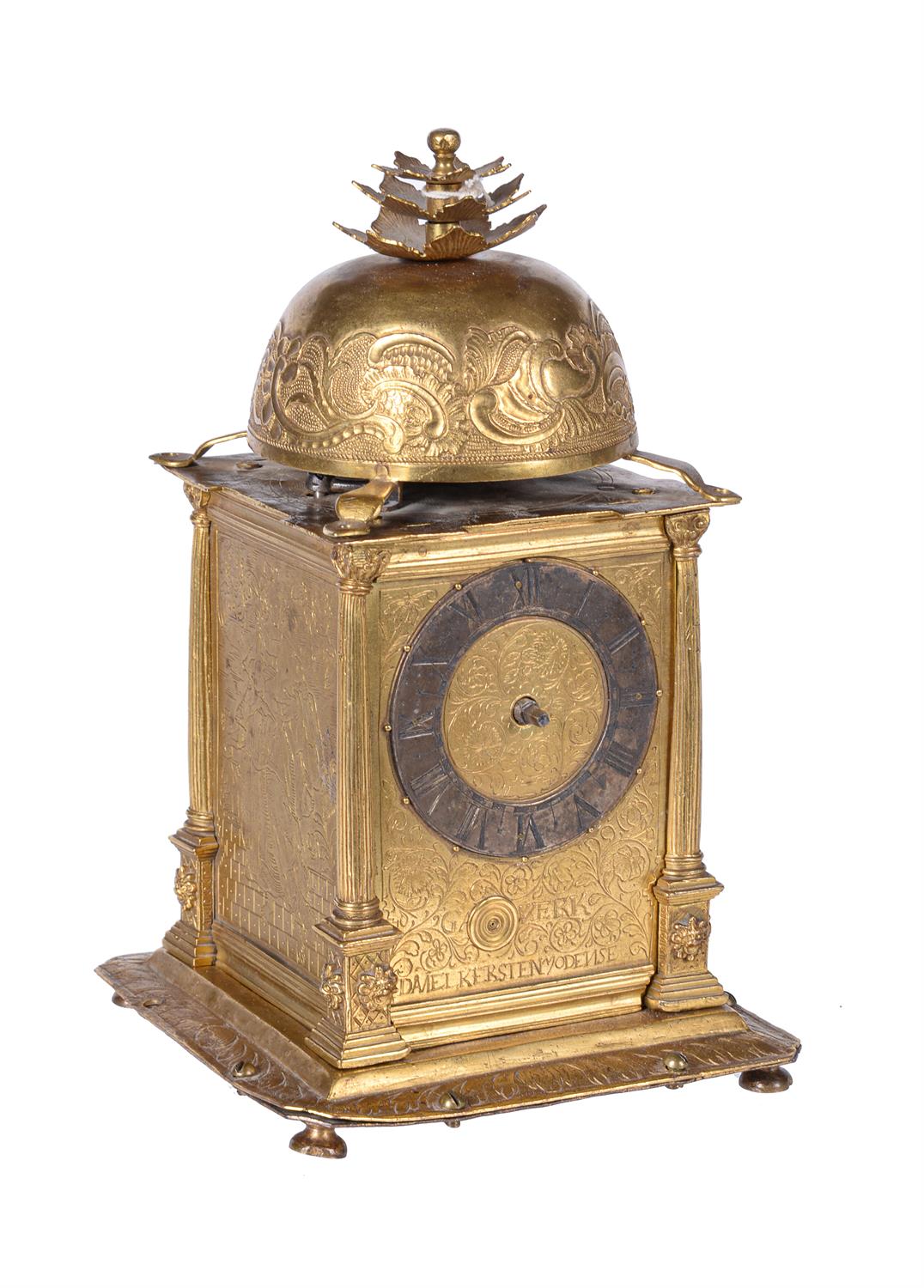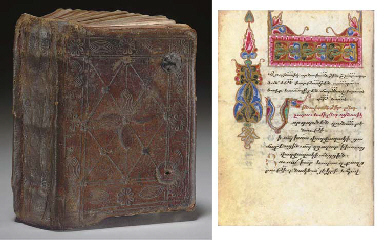A LATE 16TH CENTURY FLEMISH GILT-BRASS ASTROLABE Attributed to the Arsenius workshop at Louvain, circa 1570. Unsigned and undated. International Checklist No. 562 The throne is attached to a curved bar that is screwed to the limb. At the centre is a shield with the arms of Reichhofrat and Vizekanzeler Jacob Kurtz von Senftenau: double eagle in chief, red/white/red bars (Austria), two goats facing below. This section slides upwards to reveal a magnetic compass, intact with glass covers, engraved with the directions 'Mer: occi: Sep: ori:'. The magnetic needle with arrow head North, other end disc with crescent 'bight'. Declination no more than 10 East. The supporters are two reclining satyrs, male and female; the lower parts of the bodies end in scrolls. Above is a shackle and ring. On the reverse is a sun burst, and above is the motto 'NEL TROPO LVME SVO VIEN A CELARSI'. Below the ring is a 6-petalled rosette. The mater is composed of a plate fitted by 14 rivets to the limb. The limb is divided in degrees, 0-90 in quadrants, subdivided in half degrees, numbered every 10. Also divided in twice twelve hours. The centre of the mater is engraved with a quadratum nauticum , which gives the directions of the thirty-two winds, named in Dutch and Italian. To fit into the mater are three plates, covering five latitudes, 39 to 51. They have the usual azimuths at 5, almucantars at 2, and Houses of Heaven. Plate 1A: 39 1B: 42 Plate 2A: 45 2B: 48 Plate 3A: 51 3B: tablet of horizons; shadow square; equal to unequal hours diagram. On the back is a universal stereographic projection, with 14 stars positioned and named. The edge is divided in degrees, 0-90 in quarters, subdivided in half degrees. The regula is present, but the cursor and brachiolum are lacking. Star Names on the Back Eridani extremum Cor Oculis tauri Extra cau vrsae ma Hircus Arcturus Orionis sin. pes Lra Canopus Aquila Canis maior Cauda cgni Canicula Postrema aqua fu : The rete is in the familiar Flemish 'tulip' pattern, with pointers for forty stars, each with governing planet(s) and magnitude. Zodiac and calendar are on the ecliptic circle; 1st point of Aries nearly 21. Signs are numbered in roman: Aries I; Pices XII. there are scratched numbers on the back identifying star pointers, and these are the same as on many other Arsenius astrolabes. STAR NAMES ON THE RETE Cauda ceti Arcturus Venter ceti Bootis .in: humerus Medusae caput Lanx boreae clarior Per.ei latus dex. Coro: .eptentrional.s Nare ceti Cor Scorp Oculus Caput Hercu: Hircus ophiu: capu. orio: .in: pes Caput draconis orio: .in: humerus Lra orionis dex: humus Aquila Canis maior Cau: cg Canicula Cephei dex. hum. Hdrae clara Cauda capricorni Cor Pegasi rictus Vr.a maior [7 pointers] Dexter hum. Crateris fundus Crus aquar Dor.um [Leo] Pega.. crus. Cauda leonis Pega.. hume Corui ala dex: Pega.. vmbil. Spica virginis Pega.. extrema ala The pin is fixed to the regula, passes through the alidade, and is held by a wing-nut. the alidade has a pair of sights, with a notch at the top edge, small and large pin-holes. One arm of the alidade has a solar declination scale, the other two hour scales: Horae ortus 1-10, Horae occasus 12-2 (hours from the rising and setting of the sun). 7 in. (18.5 cm.) diam.
A LATE 16TH CENTURY FLEMISH GILT-BRASS ASTROLABE Attributed to the Arsenius workshop at Louvain, circa 1570. Unsigned and undated. International Checklist No. 562 The throne is attached to a curved bar that is screwed to the limb. At the centre is a shield with the arms of Reichhofrat and Vizekanzeler Jacob Kurtz von Senftenau: double eagle in chief, red/white/red bars (Austria), two goats facing below. This section slides upwards to reveal a magnetic compass, intact with glass covers, engraved with the directions 'Mer: occi: Sep: ori:'. The magnetic needle with arrow head North, other end disc with crescent 'bight'. Declination no more than 10 East. The supporters are two reclining satyrs, male and female; the lower parts of the bodies end in scrolls. Above is a shackle and ring. On the reverse is a sun burst, and above is the motto 'NEL TROPO LVME SVO VIEN A CELARSI'. Below the ring is a 6-petalled rosette. The mater is composed of a plate fitted by 14 rivets to the limb. The limb is divided in degrees, 0-90 in quadrants, subdivided in half degrees, numbered every 10. Also divided in twice twelve hours. The centre of the mater is engraved with a quadratum nauticum , which gives the directions of the thirty-two winds, named in Dutch and Italian. To fit into the mater are three plates, covering five latitudes, 39 to 51. They have the usual azimuths at 5, almucantars at 2, and Houses of Heaven. Plate 1A: 39 1B: 42 Plate 2A: 45 2B: 48 Plate 3A: 51 3B: tablet of horizons; shadow square; equal to unequal hours diagram. On the back is a universal stereographic projection, with 14 stars positioned and named. The edge is divided in degrees, 0-90 in quarters, subdivided in half degrees. The regula is present, but the cursor and brachiolum are lacking. Star Names on the Back Eridani extremum Cor Oculis tauri Extra cau vrsae ma Hircus Arcturus Orionis sin. pes Lra Canopus Aquila Canis maior Cauda cgni Canicula Postrema aqua fu : The rete is in the familiar Flemish 'tulip' pattern, with pointers for forty stars, each with governing planet(s) and magnitude. Zodiac and calendar are on the ecliptic circle; 1st point of Aries nearly 21. Signs are numbered in roman: Aries I; Pices XII. there are scratched numbers on the back identifying star pointers, and these are the same as on many other Arsenius astrolabes. STAR NAMES ON THE RETE Cauda ceti Arcturus Venter ceti Bootis .in: humerus Medusae caput Lanx boreae clarior Per.ei latus dex. Coro: .eptentrional.s Nare ceti Cor Scorp Oculus Caput Hercu: Hircus ophiu: capu. orio: .in: pes Caput draconis orio: .in: humerus Lra orionis dex: humus Aquila Canis maior Cau: cg Canicula Cephei dex. hum. Hdrae clara Cauda capricorni Cor Pegasi rictus Vr.a maior [7 pointers] Dexter hum. Crateris fundus Crus aquar Dor.um [Leo] Pega.. crus. Cauda leonis Pega.. hume Corui ala dex: Pega.. vmbil. Spica virginis Pega.. extrema ala The pin is fixed to the regula, passes through the alidade, and is held by a wing-nut. the alidade has a pair of sights, with a notch at the top edge, small and large pin-holes. One arm of the alidade has a solar declination scale, the other two hour scales: Horae ortus 1-10, Horae occasus 12-2 (hours from the rising and setting of the sun). 7 in. (18.5 cm.) diam.









.jpg)




Testen Sie LotSearch und seine Premium-Features 7 Tage - ohne Kosten!
Lassen Sie sich automatisch über neue Objekte in kommenden Auktionen benachrichtigen.
Suchauftrag anlegen